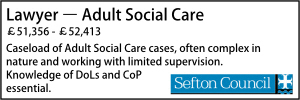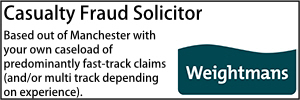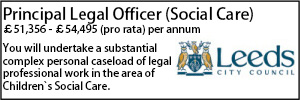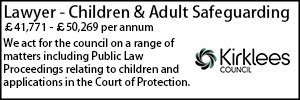Phelps v The London Borough of Hillingdon - 25 years on
- Details
John Friel and Jim Hirschmann look at the development of caselaw on educational claims following the landmark House of Lords ruling in Phelps.
Phelps v The London Borough of Hillingdon [2001] 2 AC 619; [2000] ELR. 499 was decided 25 years ago. It followed the case of X (Minors) v Bedfordshire County Council and others [1995] 2 AC 633. These cases made new law. They decided, for the first time, that liability in negligence lay in claims for education against Local Authorities. This was a new development in the law.
The background leading up to Phelps in the Lords
X (Minors) v Bedfordshire concerned several joined appeals. Some concerned actions against Local Authorities for failing to safeguard children from parental abuse by utilising their statutory powers to investigate adequately. It also concerned three education cases (E (A Minor) v Dorset County Council, Christmas v Hampshire County Council, and Keating v London Borough of Bromley). The education claims were for a failure to refer one plaintiff for an assessment of his SEN, in the other two cases it was for a negligent failure to make proper provision for the pupil’s SEND. All cases concerned the question of whether there was an actionable cause of action (the claims having been struck out in first instance). In the result, the House of Lords dismissed the social care claims but allowed the education claims.
Unusually, within the period of five years, the issue of liability in principle arose again in the House of Lords. The Phelps claim was wider than the earlier claims in X (Minors). The lead case of E (A Minor) v Dorset, had been a more restricted claim and based its claim for liability in negligence on the landmark case against the National Health Service, Cassidy v The Minister for Health [1951] 2 KB 343 (i.e that an employer may be liable for the negligent acts of a member of staff whether or not that individual member of the staff was themself in breach of a separate duty of care that they owed to the plaintiff).
Phelps concerned a successful claim that was being appealed. Pamela Phelps had brought, on the facts, a successful negligence claim against the London Borough of Hillingdon ([1998] ELR 38). The decision of Garland J, at first instance, was that the Educational Psychologist in the case, Ms Melling, owed a duty of care to Ms Phelps on the basis that her findings, recommendations and advice would be accepted by Ms Phelps through her parents, and relied upon by the London Borough of Hillingdon and the schools. Hillingdon was vicariously liable for the psychiatrist’s breach of that duty (in that she failed to diagnose Pamela Phelps as dyslexic and advise accordingly). Hillingdon appealed to the Court of Appeal challenging the Judge’s findings that the damage claims were compensable in tort, and that there was a duty of care, causing damage.
The Court of Appeal gave judgment in Phelps v London Borough of Hillingdon [1998] ELR 587; [1999] 1 WLR 500. The most significant judgment in the Court of Appeal was Stuart Smith LJ, who was supported by the other members of the Court of Appeal. While Stuart Smith LJ accepted on the face of it the approach of the House of Lords in X (Minors), however he did not consider that an educational psychologist or a teacher could be liable. Indeed, he thought it a matter of great concern that the local education authority’s non liability could be directly circumvented by suing the individual psychologist or teacher and claiming that the Authority was vicariously liable. Stuart-Smith LJ stressed that the Hillingdon Educational Psychology Service was not a service available for the public generally, but was set up by Hillingdon to provide advice for the local authority and its employees in the discharge of their statutory functions in education. Thus, there should be no liability. Further, that there was nowhere near enough evidence to establish assumption of responsibility by the educational psychologist herself (Ms Melling). Stuart-Smith LJ also considered, at [74] that Garland J had imposed “too high a standard of duty on Miss Melling”. Otton LJ agreed. [1] The House of Lords did not agree and allowed the appeal.
Phelps in the Lords
The House of Lords in Phelps consisted of seven justices. It was therefore a very powerful House of Lords and plainly intended to settle this matter once and for all based on the Court of Appeal’s attempt to reverse X (Minors). Judgment was given in detail by Lord Slynn, Lord Clyde, Lord Millet and Lord Nicholls. Overall, for slightly different reasons, all agreed that the appeal in Phelps would be allowed as well as in three of the other cases, including G v Bromley, which was argued by one of the authors of this paper.
Lord Slynn identified the issues that as a result of a failure by an educational psychologist to take care, it may mean that the child suffers “emotional, psychological harm, perhaps even physical harm”. He stated that there can be no doubt and if foreseeability and causation are established, psychological injury may constitute damage for the purpose of common law. The same applied to “a failure to diagnose a congenital condition and to take appropriate action as a result of which failure a child's level of achievement is reduced, which leads to loss of employment and wages.”
The House of Lords rejected the argument that the imposition of liability would interfere with the carrying out of services which were required by statute. They firmly applied Bolam v Friern Hospital Management Committee [1957] 1 WLR 582 at 587 per McNair J, namely:
“A doctor is not guilty of negligence if he has acted in accordance with a practice accepted as proper by a responsible body of medical men skilled in that particular art…Putting it the other way round, a man is not negligent if he is acting in accordance with such a practice, merely because there is a body of opinion that would take a contrary view”.
Applying that test, the House of Lords held that the Judge was both entitled and right to find that Ms Melling owed a duty of care. He was equally entitled to hold that if she was in breach of that duty, Hillingdon was vicariously liable. A second finding of negligence was that she should have reconsidered or “thought again when the Plaintiff made so little progress despite special needs teaching”. The House of Lords cited the Judge who held that, “Had she been taught appropriately at school, then she would have been somewhat perhaps substantially more literate than she is now”. The consequence holding was that she would have been in the position to take on work which included a greater element of literacy, so that consequences of her dyslexia could have been remediated. Garland J in fact found that the fact that the Plaintiff responded to teaching suitable for dyslexia demonstrated that the earlier failures had cost her and lost her opportunities.
Direct liability was rejected by the House of Lords, and in fact was not argued in G v Bromley. It was held that since a Local Authority “can only act through its employee or agents and if they are negligent, vicarious liability would arise, it may rarely be necessary to invoke a claim for direct liability”.
In looking at the case of G v Bromley, Lord Slynn referred to the judgment below in the Court of Appeal (Gower v London Borough of Bromley [1999] ELR 356), Auld LJ, in particular that teachers have a duty to exercise reasonable skills when they are teaching and otherwise responding to the educational needs of their pupils and that those responsible for teachers may be vicariously liable for the teacher’s negligence. Lord Nicholls agreed but added more on the vicarious liability for teachers. He raised the question, do teachers have the duty to all their pupils, not simply those with Special Educational Needs, and concluded there was no escape from the conclusion that teachers do owe such duties to all their pupils.
Lord Clyde, in his judgment, started from the position that there was no question that the teacher has a duty of care for the physical safety of a child attending school when under the charge of the teacher. He raised the question and answered it affirmatively explaining that he could not immediately see why the law should not admit the possibility of a duty of care upon professional employees of an education authority. Obviously, this applied to other schools maintained outside of the educational authority sphere.
Lord Nicholls left open the question of direct liability rather then vicarious liability for a local authority, he plainly envisaged liability for the proprietor of a school or service.
The last judgment is that of Lord Millet which starts off as though he was in complete agreement with the Court of Appeal and then reverses into agreement with Lord Slynn and the remainder of the house. It is an interesting judgment as he was plainly persuaded against his own views to agree with everybody else.
Developments since Phelps
Although the object of this article is to consider matters in the education sphere, following X (Minors) v Bedfordshire, the House of Lords considered again the issue of whether or not there was liability against Local Authorities and professionals in the social care area in Various Claimants v The Institute of the Brothers of Christian Schools [2013] 2 AC 1. It is now clear that the House of Lords would no longer consider X (Minors) as exempting social care claims. So far as the situation in Phelps is concerned at this point, when the case finished it left open the issue of whether it was capable of being a direct duty of care in relation to the exercise of education discretion in the special educational needs field. It then moved on.
In Woodland v The Swimming Teachers Association and Others [2013] UKSC 66; [2014] AC 537, the Claimant who was a pupil at a school in the local authority’s area and suffered a severe brain injury during a school swimming lesson at a pool run by another local authority. The swimming teacher and the lifeguard present during the incident were employed by an independent contractor who organised and provided the lesson. The Supreme Court had to deal with the question of the local authority’s direct duties of care because there was no claim that the local authority was vicariously liable for the independent contractors. It was held that the local authority owed a direct duty of care to ensure the claimant’s swimming lessons were carefully conducted and supervised by whomsoever they might get to perform those functions. The claimant was entrusted to the school for certain essential purposes which included teaching and supervision. The swimming lessons were an integral part of the school’s teaching function. They occurred during school hours at a place of the school’s choice. The teaching and supervisory functions of the school and the control of the child that went with them were delegated to the independent contractors to allow the swimming lessons to take place.
Lord Sumption at paragraph 25 said:
“The responsibilities of fee-paying schools are already non-delegable because they are contractual and the possibility of contracting out of them is limited by legislation. In this particular context, there seems to be no rational reason why the mere absence of consideration should lead to an entirely different result when comparable services are provided by a public authority. A similar point can be made about the technical distinctions that would otherwise arise between privately funded and NHS hospital treatment”.
Lord Sumption equated the duty of care owed by a Local Authority in maintained schools with the contractual obligations owed by independent schools to its pupils. In any event, one ought to consider that by 2013, the NHS was visibly using private contractors and that no doubt would have been an influential factor in relation to the Supreme Court decision.
In Michael v The Chief Constable of South Wales [2015] UKSC 2; [2015] AC 1732, the Supreme Court held there was no difference between independent schools and maintained schools in relation to the imposition of a duty of care.
The original claims in negligence, based on vicarious liability have now been extended to the principle of a non-delegable duty of care which, although it is a form of personal rather than vicarious liability, operates to plug the gap in the protection for individuals that would otherwise arise as a result of limits of claims in vicarious liability. The leading authority on this issue is as already indicated, Woodland v The Swimming Teachers Association and Others. It is appropriate to examine the circumstances where non-delegable duty of care arises.
It arises where the claimant is a patient or child or pupil is especially vulnerable or dependent upon the protection of the Defendant against the risk of injury. This is a long-term extension of the original duty of care to protect children’s safety. It requires an antecedent relationship between the Claimant and the Defendant independent of the negligent act or omission itself. The features of the relationship can be described as:
- Placing the Claimant in the actual custody, charge or care of the Defendant.
- In a situation from which it is possible to impute to the Defendant an assumption of a positive duty to protect the Claimant from harm and not just a duty to refrain from conduct which will foreseeably damage the Claimant. It is characteristic of such relationships that they involve an element of control over the Claimant which varies in intensity from one situation to another but is very clearly substantial in the case of school children/pupils.
- Another feature is that the Claimant has no control over how the Defendant chooses to perform those obligations, whether personally or through employees or through third parties. The situation also covers where the Defendant has delegated to a third party some function which is an integral part of the positive duty which he or she has assumed towards the Claimant. The third party is therefore exercising for the purpose of the function the delegating party’s duty. Thus, delegating to him the Defendant’s custody, care and control of the Claimant. Generally, there will be an element of control as indicated.
- Finally, that the third party has been negligent, not in some collateral aspect of the duty but in the performance of the very function assumed by the Defendant and delegated by the Defendant to him or her.
A non-delegable duty of care will thus potentially arise where a school or local authority arranges for third parties to provide some element of the curriculum to its pupils, whether on or off the school premises. This does not exempt the third party from liability but that is not the worry for the Claimant. The school or local authority will normally have a contractual arrangement with the third party and liability will normally be covered, probably by insurance under the contractual arrangement.
The issue of duty of care has not been explored in great detail in relation to higher education. There is some authority for the fact that the non-delegable duty of care will not generally apply in respect of higher education, but it may do so if the student is especially vulnerable.
The net result of the above development of the law is
- That where a child or pupil’s safety is involved, it is clear that the courts have imposed responsibility upon the school or local authority for the organisation of and delivery of the particular educational experience, whether that might be within the general terms of the curriculum or the associated aspects of the curriculum to include sport and community access.
- While it is, as demonstrated by the case of Ms Phelps, possible to prove negligence in the educational sector resulting in damage, such a claim is difficult to prove. A failure to diagnose dyslexia or a failure to advise on effective remedial action for the effect of a disability which is inherent is not always clearcut [2]. Liability depends on its facts, the issue we draw attention to is that it will often be difficult to prove a breach of duty of care.
- As illustrated by Ms Phelps, the expert evidence is crucial and, for those who have practiced in this field for a substantial period of time, the experts who gave evidence in that case, particularly on behalf of Ms Phelps were well-known in the field, and very established. It is plain that expert evidence is crucial in educational negligence cases [3].
Looking forwards
We now consider what the implications of the development of the case law in this field constitute.
It is clear that leading on from X (Minors) v Bedfordshire, the law has developed to both cover vicarious liability of all educational professionals, particularly teachers and educational psychologists, and extend it into direct liability if the particular criteria are not met which require the assumption of responsibility overall for the particular pupil or school child.
Despite the reduction of legal aid, the law has progressed, although cases based on pure negligence in relation to teaching, i.e. a failure to identify dyslexia or a failure to remediate other learning difficulties, and/or ignore them have not obviously been pursued for a substantial period. Nonetheless, the duty of care has extended and the responsibility of those in the education sector for negligence acts has widened.
If one looks at damages in Phelps, after allowing for inflation in today’s terms, they are definitely substantial enough to justify bringing a case where the evidence is of sufficient quality. The judgment of Garland J in Phelps v London Borough of Hillingdon at first instance [1998] ELR 38, deals with the quantum of damages at page 64/65. The total quantum was £44,056.50. Included in that were general damages, loss of earnings and special damage. Special damage was awarded for past and future tuition. Nothing was awarded for past loss of earnings because Ms Phelps had been signed off as unfit for work. Had she been fit to work, the damages would plainly have been more substantial. In relation to future loss of earnings, Garland J stated, “I regard any arithmetical calculation as unreal. It is quite impossible to make any specific findings to the plaintiff as she might have been”. He goes on then to state, “I am driven to adopt the approach in Belmire v South Cumbria Health Authority [1993] PIQR Q1 and arrive at a lump sum representing the loss of opportunity to earn at a higher rate rather than that which the plaintiff is now able to command”, and as a result he awarded £25,000. General damages, to represent the loss of congenial employment, was low at £12,500. Nonetheless, the damages today allowing for inflation, on a rough calculation which we emphasize would be about £100,000. Had there been a loss of past earnings as pointed out, it would be more.
Equally, as is illustrated by the amount of young people who are unable at the moment to work, mental health difficulties have increased very substantially, particularly anxiety. The question therefore arises whether mental health difficulties, particularly anxiety, might increase damages. In Verderame v Commercial Union Insurance Co Plc [2000] Lloyd’s Rep PN 557, a Court of Appeal case in which there was professional negligence, it was held that where a duty of care arises in respect of economic loss, there will be no recovery of damages for mental distress, anymore than there would be if the professional negligence claim were brought, as is more common in contract. For mental distress in contract where professional negligence can occasionally lead to an award summed up on Watts v Morrow [1991] 1 WLR 1421 by Bingham LJ in the following terms:
“A contract-breaker is not in general liable for any distress, frustration, anxiety, displeasure, vexation, tension or aggravation which his breach of contract may cause to the innocent party.
This rule is not, I think, founded on the assumption that such reactions are not foreseeable, which they surely are or may be, but on considerations of policy. But the rule is not absolute. Where the very object of a contract is to provide pleasure, relaxation, peace of mind or freedom from molestation, damages will be awarded if the fruit of the contract is not provided or if the contrary result is procured instead.”
Although there is no clear authority on this issue, contracts for the provision of education do involve the joy of learning and achieving. One of the authors in a first instance case involving a course of vehicle restoration for classic vehicles which was in breach of contract did recover at first instance damages for lack of satisfaction, displeasure and frustration as a result of the incompetent delivery of the course and the fact that the course was substantially misrepresented. In our view, that is an issue that remains open and capable of argument. That is an issue that is likely to occupy the higher courts at some stage in the future.
John Friel and Jim Hirschmann are barristers at 3PB.
[1] It may be interesting to the reader that, at the invitation of counsel in the Dorset case, Otton LJ had addressed the Education Law Association and expressed in very clear views that he personally was against liability in this field before the case came up. Further, that he considered the issue of resources very important and that the statutory regime was the same as in social care either for children or for adults. It has to be said later that the House of Lords in T v East Sussex decided the statutory regime was different. But it is interesting that the Court of Appeal was constituted by Judges who were at least in one case, and very probably in more, on record as opposing the concept of liability in this field.
[2] See Liennard v Slough Borough Council [2002] ELR 527. The court dismissed the claim applying the Bolam test and held that the teachers could reasonably believe that at the time the Claimant suffered from a discipline, or behavioural problem rather than having special educational needs.
[3] Indeed, when applying the principles to higher education, in Abramova v Oxford Institute of Legal Practice [2011] ELR 385, the court dismissed the claim due to the absence of expert evidence which was necessary, see also DN (by his father and litigation friend RN) v London Borough of Greenwich [2004] EWCA Civ 1659; [2005] 1 FCR 111.































